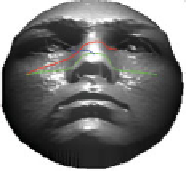Graphics Reference
In-Depth Information
However, the information captured by combining local SIFT descriptors of the keypoints
detected in a face scan is not discriminant enough for the accurate recognition of the subjects'
identity. Additional information necessary to discriminate the identity of each subject is
captured by considering relational information between pairs of keypoints in the form of
facial curves
, as discussed in the following sections.
Facial Curves and Their Saliency
Each pair of SIFT keypoints detected on a depth image is used to identify a
facial curve
, that
is, the 1D function of the depth values of the pixels that lay on the segment connecting the two
keypoints. More formally, let
I
(
x
) with
x
2
be the depth image representing a face scan,
x
1
and
x
2
two keypoints, then the facial curve identified by the ordered pair (
x
1
,
∈
x
2
) is defined as
I
x
1
,
C
x
2
(
t
)
=
I
((1
−
t
)
x
1
+
tx
2
)
,
t
∈
[0
,
1]
.
(5.1)
As an example, Figure 5.10 shows three facial curves derived from the depth image of a
sample individual. It can be observed that the curves capture the shape of the face across
different paths and in particular the nose protrusion.
Comparison of the identity of two face representations is accomplished by matching their
corresponding facial curves. Given the facial curve
C
1
(
t
),
t
∈
[0
,
t
1
] identified by the keypoint
pair (
x
1
,
x
2
) of the face scan
I
1
, and the facial curve
C
2
(
t
),
t
∈
[0
,
t
2
] identified by the keypoint
pair (
x
3
,
x
4
) of the face scan
I
2
, the distance between the two facial curves is measured as
min
{
t
1
,
t
2
}
D
C
1
(
t
)
, C
2
(
t
))
=
|
C
1
(
t
)
−
C
2
(
t
)
|
.
(
d
t
(5.2)
0
In general, it is expected that not all the facial curves have the same relevance in discrim-
inating between different subjects. This suggests to evaluate the
saliency
of facial curves by
assuming the higher the saliency of a curve
, the lower the uncertainty about the identity of
the person that is represented in the depth image if the curve
C
is observed. To this end, an
information theoretic model is defined to associate with a generic curve a value of saliency.
Formally, let's assume that the 3D face scans of
n
different subjects are available and let
X
be
a discrete random variable taking values in the set
C
{
x
1
,...,
x
n
}
, representing the identity of
1
1
1
0.8
0.8
0.8
0.6
0.6
0.6
0.4
0.4
0.4
0.2
0.2
0.2
0
0
0
0
10
20
30
40
50
60
0
20
40
60
80
0
5 1015202530
Figure 5.10
Three facial curves between pairs of keypoints of a sample face. The horizontal axis reports
the number of pixels between the two keypoints, whereas the vertical axis represents the gray-level of
the depth image along the curve normalized in [0,1]


